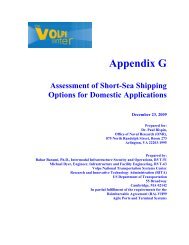ERRV Viking Islay - Marine Accident Investigation Branch
ERRV Viking Islay - Marine Accident Investigation Branch
ERRV Viking Islay - Marine Accident Investigation Branch
- No tags were found...
Create successful ePaper yourself
Turn your PDF publications into a flip-book with our unique Google optimized e-Paper software.
1.2.2The initial accidentIt is likely that the noise made by the anchor chain during the night was discussedbetween Mr MacFadyen and the two day workers 3 , Mr Ebertowski and Mr O’Brien, overbreakfast, before they started work at 0800.At 0800, the master and Mr MacFadyen took over the bridge watch. At about 0900,Mr MacFadyen told the master that the two day workers wanted to go into the chainlocker to tie off the anchor chain and so stop it banging. The master agreed that thiswork could be done, but later in the morning as a helicopter movement to the rig wasexpected shortly.Just before 1000, <strong>Viking</strong> <strong>Islay</strong> stood by for the helicopter movement. Sometime afterthe helicopter departed, the master went to his cabin to use the lavatory, leaving MrMacFadyen in charge of the watch and alone in the wheelhouse. At about 1055, thetwo day workers, carrying a portable VHF radio, went forward to enter the chain locker.They took no other equipment with them, and no safety related documentation (such asa risk assessment or a permit to work) was completed.The day workers went forward and opened the hatch down to the foc’sle store fromthe foredeck. This store area was used to store mooring ropes and other generaldeck gear. As a regularly used working area, the store was well lit and was naturallyventilated.The two day workers went to the aft part of the foc’sle store and lifted the looseduckboards, beneath which were three access manholes. The forward hatch servedthe fore peak water ballast tank, and the after two gave access to the port andstarboard sides of the anchor chain locker. Although there were two manholes, theinternal dividing bulkhead which separated the two anchor chains only extended toabout half the height of the chain locker, and the upper parts of the spaces werecommon. The manholes serving the chain locker were smaller than that serving theballast tank, and were square in shape rather than the more conventional oval found atthe ballast tank access. The heavy steel manhole covers were secured with eighteen24mm nuts and bolted down onto a rubber gasket, so forming a watertight seal (Figure5).The day workers removed only the starboard cover to access the compartment, andno portable lighting or ventilation fans were rigged. The atmosphere within the chainlocker was not tested.As all three people directly involved in the initial accident died, it has been necessaryfor MAIB to construct the most likely scenario from the evidence available. It was likelythat:Mr Ebertowski entered the chain locker to tie off the chain; this was a one manjob. Mr O’Brien, the leading hand 4 , stood by at the entrance, keeping in radiocontact with Mr MacFadyen in the wheelhouse. As Mr Ebertowski descendedinto the chain locker, he collapsed. Mr O’Brien saw this, and called the bridgeby VHF to alert Mr MacFadyen to the problem.Mr O’Brien then entered the chain locker in an attempt to rescue Mr Ebertowski,but he too was overcome and collapsed at the bottom of the chain locker, partlyon top of his colleague.3 Day workers: seamen who do not keep routine watches, but carry out routine work during the day.4 Leading hand: The senior day work seaman, nominated by the master as “in charge” of the other dayworker.7
















